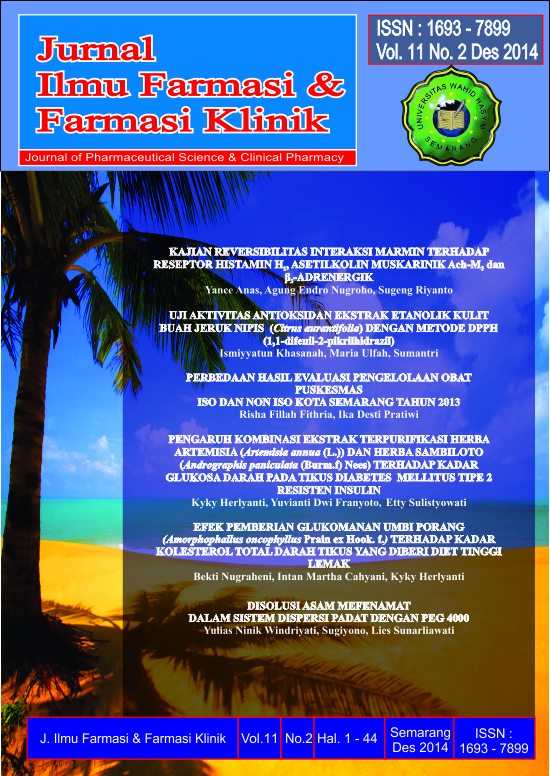Main Article Content
Abstract
ABSTRACT
Citrus aurantifolia is known contains flavonoid compound and high Vitamin C. One of the
effects of flavonoid and Vitamin C are antioxidant. This research aims to knowing the antioxidant
activity of citrus aurantifolia etanolic extract by using the DPPH (1, 1-difenil-2-pikrilhidrazil) method
and to knowing the active compound that containing whithin.
The research was done by making level series of citrus aurantifolia etanolic extract, they were
10, 20, 40 and 80 μg/ml. As a standard of comparison was used vitamin C with concentrations 1, 2, 4
and 8 μg/ml. As a blank was used DPPH 0,1 mM. The antioxidant activity test was done by the DPPH
method. The achieved data was counted to know it’s antioxidant activity. The statistical analysis was
used T-Test. To know IC50 (Inhibition Concentration)50 was used the probit analysis and to know it’s
active compound content was done an identification with TLC (Thin Layer Chromatography).
The result of the research shows that etanolic extract of citrus aurantifolia has antioxidant
activity IC50 about 54,458 μg/ml and 4,768 μg/ml for vitamin C. The statistical test result of antioxidant
activity shows that there is no any significant difference. The TLC result shows that compound
contained in etanolic extract of citrus aurantifolia are flavonoid and Vitamin C.
Keywords: Citrus aurantifolia extract, DPPH method, antioxidant and IC50.
Citrus aurantifolia is known contains flavonoid compound and high Vitamin C. One of the
effects of flavonoid and Vitamin C are antioxidant. This research aims to knowing the antioxidant
activity of citrus aurantifolia etanolic extract by using the DPPH (1, 1-difenil-2-pikrilhidrazil) method
and to knowing the active compound that containing whithin.
The research was done by making level series of citrus aurantifolia etanolic extract, they were
10, 20, 40 and 80 μg/ml. As a standard of comparison was used vitamin C with concentrations 1, 2, 4
and 8 μg/ml. As a blank was used DPPH 0,1 mM. The antioxidant activity test was done by the DPPH
method. The achieved data was counted to know it’s antioxidant activity. The statistical analysis was
used T-Test. To know IC50 (Inhibition Concentration)50 was used the probit analysis and to know it’s
active compound content was done an identification with TLC (Thin Layer Chromatography).
The result of the research shows that etanolic extract of citrus aurantifolia has antioxidant
activity IC50 about 54,458 μg/ml and 4,768 μg/ml for vitamin C. The statistical test result of antioxidant
activity shows that there is no any significant difference. The TLC result shows that compound
contained in etanolic extract of citrus aurantifolia are flavonoid and Vitamin C.
Keywords: Citrus aurantifolia extract, DPPH method, antioxidant and IC50.
